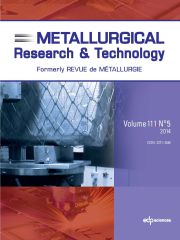Article contents
Study of structural stability of blast furnace hearth ceramiclining
Published online by Cambridge University Press: 19 December 2011
Abstract
Nowadays, finding ceramic materials with good physical-chemistry characteristics to makeceramic cups is no longer a big difficulty. However, the stability of the construction,the anti-penetration ability and the adaptability of the working profile of the hat faceof the ceramic cup are of critical importance to prolong the campaign life of the ceramiccup itself and thus the BF hearth. In a lot of cases, the so-called “ceramic cup” isformed just by one, two or more rings of the standard-shaped ceramic bricks which areinstalled closely against the carbon hot face. In these linings, there are manypenetrating linear joints from the hot face to the cold face through the ceramic lining.Both the overall stability of the construction and the anti-penetration ability of thelining are very poor. Therefore, the goal of installing a ceramic cup, to protect thecarbon lining from the erosion of hot metal, would be difficult to achieve and thelifetime of the ceramic cup would not be long no matter what excellent materials werebeing used. However, an “Integrated Ceramic Cup” structure for the BF hearth is composedof special-shaped ceramic blocks which are all interlocked with each other. In such aconstruction, there is no linear breakthrough joint from the hot face to the cold face ofthe ceramic lining. A ceramic lining with this structure can effectively avoid hot metaland gases penetrating into and then through the joints of the ceramic lining to attack thecarbon lining behind. As a result, the campaign life of the BF hearth, and also thecampaign life of the blast furnace, would be prolonged. Nowadays the “Integrated CeramicCup” structure has been used in many modern blast furnaces and its significant performancehas been proved.
Keywords
- Type
- Research Article
- Information
- Copyright
- © EDP Sciences, 2011
References
- 2
- Cited by


